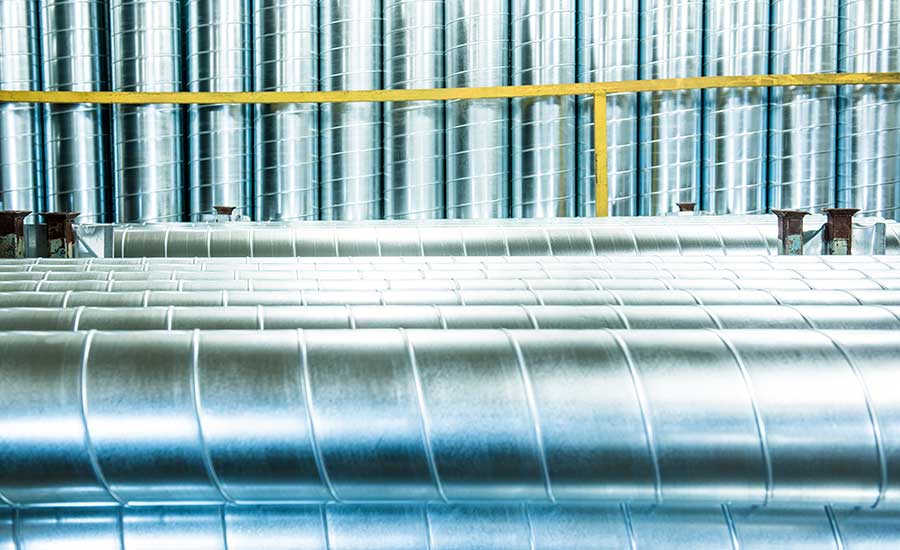Do You Know What A Spiral Flat Oval Duct Is?
What You're Looking At Isn't Just Round-Cornered Rectangular Duct
Many commercial HVAC duct systems have design principles that date back to the 1980s, which we examine every year. Operating and installation expenditures associated with these designs have totaled millions of dollars over the years. In the 1990 SMACNA HVAC Systems Duct Design guidebook, a simple illustration emerged on page 2.4 that appeared to support "common knowledge" at the time.
It was found that the installed rectangular duct section ($775 to $1375) was less expensive than the installed flat oval portion ($975 to $2100) in the comparison of a basic duct system consisting of 40' of straight duct, a 90-degree elbow, a transition and three placed taps. We are still fighting the 80s attitude that "flat oval is too costly" after 25 years and hundreds of real-world situations where that recommendation was proved to be false.
But in the last quarter of a century, a lot more than simply the "price" has changed. One of the following is true of your planned project: You must instantly switch to a circular and spiral flat oval duct design.
Construction Of Pressure And Ducting Systems
The SMACNA HVAC Duct Construction Standards are often required by designers for ductwork. What is the minimum metal thickness and reinforcing needed to keep the wall deflection to a specified amount? That is the foundation of the structural guidance in that guidebook.
Compared to rectangular and flat oval ducts, spiral ducts have no wall deflection in positive pressure. Because the curved sides may be removed, a flat oval has less area than a comparable rectangle. The smooth surface is further broken up by the 4-ply spiral lockseams, which are spaced every 4 12". Static pressure influences the amount of deflection a duct surface will have, which is why we mention "2 in. WG or more."
The SMACNA handbook has gauge-deflection charts for rectangular duct pressure categories of 12", 1", 2", 3", 4", 6" and 10" WG. Even yet, there's just one option for spiral flat ovals with diameters of less than 10 inches (WG).
Unlike rectangular duct, you'll need to utilize the identical metal gauges for 12" WG pressure and 10" WG pressure when following SMACNA regulations. The installed cost of a duct system is heavily influenced by material costs, and a one-even-gauge weight variation is equivalent to a 20% difference. Spiral flat oval weight has a significant advantage over rectangular weight when it comes to "low pressure" applications, but this advantage diminishes as the pressure class grows.
Duct Layouts That Are Straightforward And Effective
Not all of the ducts in a flat oval system are flat oval. It's a lot of spherical spiral ductwork. Round spiral duct is less costly and more efficient than rectangular duct, and no one disputes this fact. In most flat oval duct systems, the primary trunks are merely flat oval. This is a common occurrence, as the flat oval trunks are manifolded with efficient round taps. Hence, majority of your duct system's "flat oval" consists of straight spiral pipe, elbows and transition pieces. This is the point at which you may begin to save money in earnest.
Spiral flat oval duct is available in lengths ranging from 8 to 10 feet, although it may be customized to a maximum of 20 feet. This is much less duct connections and duct sealing than a normal coilline rectangular duct, which is roughly 56". The more elbows and transitions you eliminate, the more straight duct you save using flat oval. Don't think that flat oval fittings cost more than rectangular ones since they don't, because that's not the case at all.
Since the 1980s, plasma torch tables with automated programming have been used to make both flat oval and rectangular fits. In addition, some modern seam welding and lockforming technology has made the installation of flat oval fittings a lot easier than putting together the Pittsburgh locks on rectangular ones. A more cost-effective alternative to spiral flat oval duct is the more efficient use of straight ducts.
As a result, the decision should be obvious. The ideal choice for duct construction is round spiral duct, however flat oval duct is still preferable than rectangular duct if you don't have the space. Those of you still stuck in the 1980s need to wake up and realize that spiral flat oval duct has evolved into much more than a pricey rectangular duct with rounded edges.

